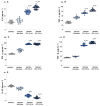Biomarkers of Oxidative Stress in Diabetes Mellitus with Diabetic Nephropathy Complications
- PMID: 37686346
- PMCID: PMC10488183
- DOI: 10.3390/ijms241713541
Biomarkers of Oxidative Stress in Diabetes Mellitus with Diabetic Nephropathy Complications
Abstract
The present study aimed to investigate and compare biomarkers of oxidative stress and the activity of antioxidant enzymes in the plasma of patients with different stages of diabetic nephropathy. For this purpose, we studied (1) the levels of reactive oxygen species and reactive nitrogen species as oxidative stress parameters, (2) lipid and protein oxidation, (3) the activity of antioxidant enzymes, and (4) cytokine production. Patients with type 2 diabetes mellitus were divided into three groups according to the loss of renal function: patients with compensated diabetes mellitus with normal renal function DMT2N0 measured as an estimated glomerular filtration rate (eGFR) ≥ 90 mL/min/1.73 m2, a group with decompensated diabetes mellitus with complication diabetic nephropathy and mild-to-moderate loss of renal function DMT2N1 (eGFR < 60 mL/min/1.73 m2: 59-45 mL/min/1.73 m2), and a decompensated diabetes mellitus with diabetic nephropathy group with moderate-to-severe loss of renal function DMT2N2 (eGFR > 30 mL/min/1.73 m2: 30-44 mL/min/1.73 m2). All results were compared with healthy volunteers. The results showed that patients with diabetic nephropathy had significantly higher levels of ROS, cytokine production, and end products of lipid and protein oxidation compared to healthy volunteers. Furthermore, patients with diabetic nephropathy had depleted levels of nitric oxide (NO), an impaired NO synthase (NOS) system, and reduced antioxidant enzyme activity (p < 0.05). These findings suggest that patients with impaired renal function are unable to compensate for oxidative stress. The decreased levels of NO radicals in patients with advanced renal complications may be attributed to damage NO availability in plasma. The study highlights the compromised oxidative status as a contributing factor to impaired renal function in patients with decompensated type 2 diabetes mellitus. The findings of this study have implications for understanding the pathogenesis of diabetic nephropathy and the role of oxidative stress and chronic inflammation in its development. The assessment of oxidative stress levels and inflammatory biomarkers may aid in the early detection and prediction of diabetic complications.
Keywords: NO radicals; NOS; diabetes mellitus; diabetic nephropathy; oxidative stress.
Conflict of interest statement
The authors declare no conflict of interest.
Figures








Similar articles
-
Systematic Inflammation and Oxidative Stress Elevation in Diabetic Retinopathy and Diabetic Patients with Macular Edema.Int J Mol Sci. 2025 Apr 17;26(8):3810. doi: 10.3390/ijms26083810. Int J Mol Sci. 2025. PMID: 40332476 Free PMC article.
-
N-acetylcysteine protects against diabetic nephropathy through control of oxidative and nitrosative stress by recovery of nitric oxide in rats.Nitric Oxide. 2018 Aug 1;78:22-31. doi: 10.1016/j.niox.2018.05.003. Epub 2018 May 18. Nitric Oxide. 2018. PMID: 29778909
-
Increased Expression of Circulating Stress Markers, Inflammatory Cytokines and Decreased Antioxidant Level in Diabetic Nephropathy.Medicina (Kaunas). 2022 Nov 7;58(11):1604. doi: 10.3390/medicina58111604. Medicina (Kaunas). 2022. PMID: 36363561 Free PMC article.
-
Nitric oxide in the normal kidney and in patients with diabetic nephropathy.J Nephrol. 2015 Jun;28(3):257-68. doi: 10.1007/s40620-014-0136-2. Epub 2014 Sep 13. J Nephrol. 2015. PMID: 25216787 Review.
-
Oxidative stress in diabetic nephropathy.Curr Med Chem. 2010;17(34):4256-69. doi: 10.2174/092986710793348581. Curr Med Chem. 2010. PMID: 20939814 Free PMC article. Review.
Cited by
-
Burdock Fructooligosaccharide Protects Against Diabetic Nephropathy in Mice by Regulating Nrf2 Signaling.Pharmacol Res Perspect. 2025 Jun;13(3):e70094. doi: 10.1002/prp2.70094. Pharmacol Res Perspect. 2025. PMID: 40264355 Free PMC article.
-
Protective effects of ghrelin on pancreas in fructose diet and streptozotocin-induced diabetic rats.J Mol Histol. 2024 Dec 14;56(1):43. doi: 10.1007/s10735-024-10329-8. J Mol Histol. 2024. PMID: 39673670
-
Challenging directions in pediatric diabetes - the place of oxidative stress and antioxidants in systemic decline.Front Pharmacol. 2024 Dec 18;15:1472670. doi: 10.3389/fphar.2024.1472670. eCollection 2024. Front Pharmacol. 2024. PMID: 39744134 Free PMC article. Review.
-
Apple Polyphenol Mitigates Diabetic Nephropathy via Attenuating Renal Dysfunction with Antioxidation in Streptozotocin-Induced Diabetic Rats.Antioxidants (Basel). 2025 Jan 23;14(2):130. doi: 10.3390/antiox14020130. Antioxidants (Basel). 2025. PMID: 40002316 Free PMC article.
-
Machine learning based identification of anoikis related gene classification patterns and immunoinfiltration characteristics in diabetic nephropathy.Sci Rep. 2025 May 1;15(1):15271. doi: 10.1038/s41598-025-99395-w. Sci Rep. 2025. PMID: 40312440 Free PMC article.
References
MeSH terms
Substances
Grants and funding
LinkOut - more resources
Full Text Sources
Medical
Research Materials
Miscellaneous

